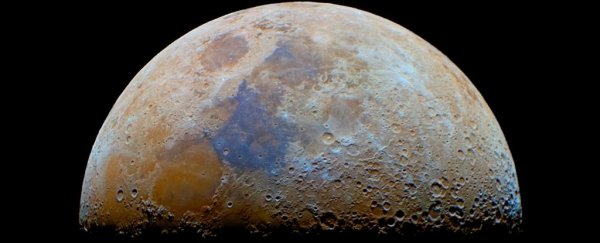No matter where you're standing on Earth, you can only ever see one face of the Moon. Its other cheek is perennially turned away from our planet, and this far side is much more pockmarked with craters than the one facing us.
The Moon's near side is covered in lunar maria, vast plains of volcanic basalt that appear as dark patches when we look up at our satellite. The reason for this two-faced appearance has remained a mystery – one that's persisted since the first spacecraft orbited the Moon in the 1960s. But a new simulation might now have solved the Apollo-era puzzle.
Piecing together the different features, computer models support the idea that a massive lunar impact once resurfaced the Moon's near side in lava flows. The differences are more than skin deep, since they're also reflected by distinct geological compositions on each side of the Moon.
Astronomers have long suspected the near side was once covered in a sea of magma that, when cooled, smoothed the rocky landscape, creating the dark blemishes we see today. But the trigger for this volcanic activity is contentious.
A massive crater at the Moon's south pole, known as the South Pole–Aitken basin (SPA), could explain the differences.
This basin is a remnant of one of the largest and oldest collisions on the Moon. Simulations show the SPA event, which happened about 4.3 billion years ago, occurred at just the right time and the right place to initiate changes to just one side of the lunar mantle.
The immense heat produced by the impact would have warmed the upper mantle on the near side to such an extent, experts think it would have led to a concentration of potassium, rare earth elements, phosphorus, and heat-producing elements like thorium.
To date, that's exactly the composition scientists have found in lunar rock samples from the near side, especially in the Procellarum KREEP Terrane (PKT), a large area known for this compositional anomaly.
"What we show is that under any plausible conditions at the time that SPA formed, it ends up concentrating these heat-producing elements on the nearside," explains planetary scientist Matt Jones from Brown University.
"We expect that this contributed to the mantle melting that produced the lava flows we see on the surface."
The fallout of the SPA event would probably have lasted for hundreds of millions of years.
In simulations, the most ancient nearside volcanic plain erupted 200 million years after the impact events. In fact, intense episodes of volcanic activity continued on the near side of the Moon for up to 700 million years post-impact.
According to experts, the reason this cheek of the Moon reacted to the hit more is both because of where the location of the impact centered the transport of heat-producing materials, and also because of slight changes in gravity.
In every scenario researchers examined, the upper mantle in the southern hemisphere heated up and began flowing toward the northern hemisphere, traveling via the near side.
Meanwhile, the upper mantle on the far side remained too cool to distribute the same material in a similar fashion.
This difference could very well have generated the asymmetry observed in the Moon's two faces.
"How the PKT formed is arguably the most significant open question in lunar science," says Jones.
"And the South Pole–Aitken impact is one of the most significant events in lunar history. This work brings those two things together, and I think our results are really exciting."
The study was published in Science Advances.
